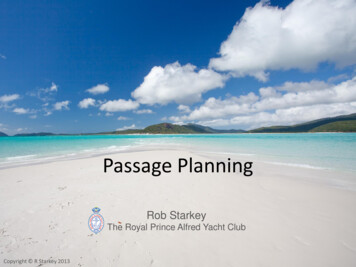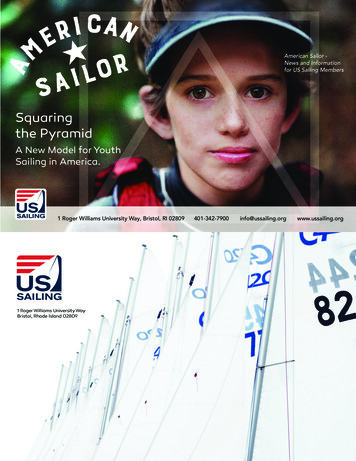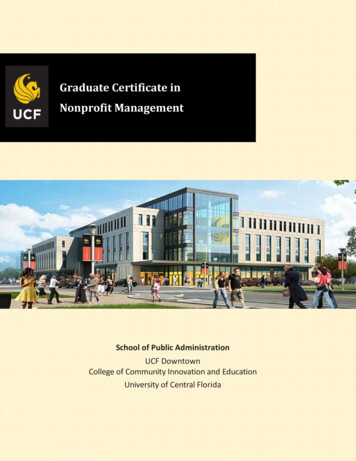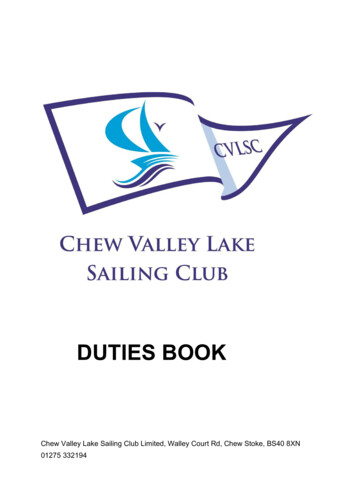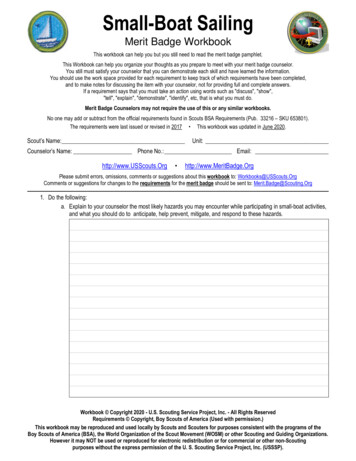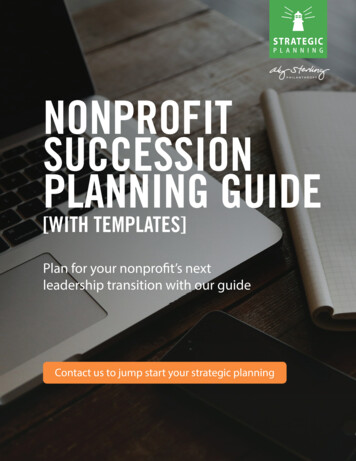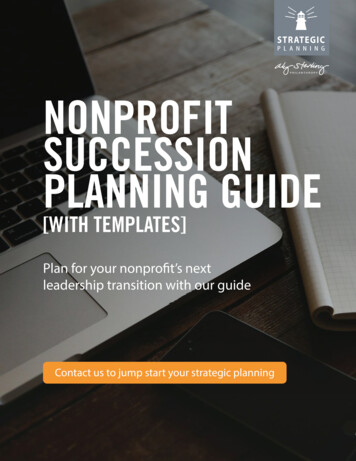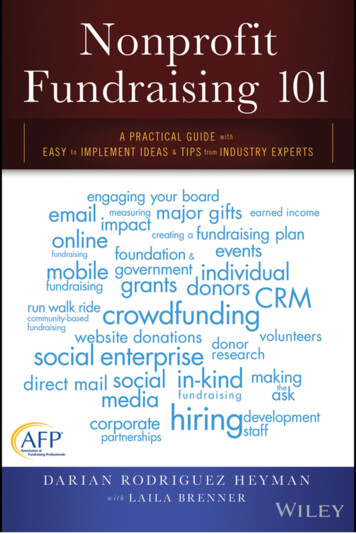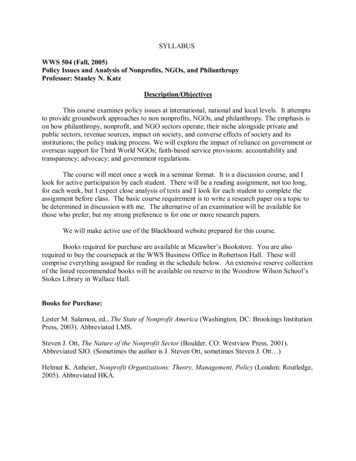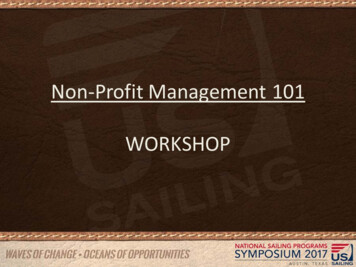
Transcription
Non-Profit Management 101WORKSHOP
Workshop AgendaGoal: To provide an overview of how to run a sailing organizationfrom budgets to strategic planning. Experienced leaders will sharethe ins and outs of the business. The workshop is geared toexecutive directors and program leadership.Agenda 1:00 – 1:10pm: Welcome and Workshop Overview 1:10 – 1:30pm: Board Governance 1:30 - 2:00pm: Strategic Planning 2:15 – 2:45pm: Finance & Fundraising 2:45 – 3:15pm: Executive Director Panel – Q&A 3:15 – 3:30pm: Summary Remarks
Board GovernanceDeveloping a High-PerformanceBoard of Directors
Why Build a High-Performance Board?When people think about boards of directors, they often picturestodgy entities that provide organizations with governance andfinancial oversight. They also think about meetings as requirementsand as something that takes people away from organizationbuilding activities.High-performance boards go well beyond governance, acting aseffective teams capable of providing the strategic and operationalsupport that help their organizations succeed.
A High-Performance Board can be a: Sounding Boardfor leadership staff to help set and evaluate your organization’stop strategic goals and challenges. Forumfor problem solving and management support. Sourceof skills and expertise. Resourcefor networking with key people outside your organization whocan help you succeed.
Levels of Cohesiveness Exceptional: adds significant value, engaged, thinkingstrategically, communicate well with each other Responsible: quorum, follow the bylaws, some strategicconversations Functional: manage to meet, but decisions not very effectiveor focus on low priority items Dysfunctional : dramatically disengaged or apatheticmembers or intense conflict
Qualities of aHigh-Performance Board of Directors1. The BOD develops itself so it can serve the organization'sneeds.2. Board members cultivate the Board as a distinct entity.3. The BOD focuses on results - and on monitoring results.4. The BOD ensures sufficient resources that are managedeffectively.
The Board develops itself so it can servethe organization’s needs. Regularly monitors its effectiveness and structure. Upholds structure of board, officers and committees andensures roles and responsibilities are clear. Has an effective decision making process and a strong senseof urgency to make key decisions in an appropriate timeframe. Recruits and approves new Board members and orients themto be effective as Board members. Ensures all necessary skills, stakeholders and diversity arerepresented on the board
Board members cultivatethe Board as a distinct entity. Board members recognize the Board as a distinct entity thatgoverns the organization. The Board is different from committees and from individualboard members The Board directs the organization via Executive Director Selects the Executive Director and assess the performance ofthe Executive Director
The Board focuses on results– and on monitoring results. The Board’s job is to ensure legal and ethical integrity andmaintain accountability Ensures effective organizational planning Expresses its goals through a written plan or policies. Regularly monitors the goals, via measures of success. The feedback loop established through the monitoringprocess creates strong levels of performance.
The Board ensures sufficient resourcesthat are managed effectively. Provides proper financial oversightRegularly reviews the finances.Helps develop and approves the budget.Ensures adequate resources by raising money and otherresources.
Traps to AvoidBoard’s failures: Weak recruitment, orientation, on-boarding of newmembers Not having strong governance policies in place Not managing personal issues or special cases, whichcan impact governance process Not knowing what is expected of them Not agreeing to what is expected of them
“High-performance boards start with boardmembers who understand their role and howbest to bring their skills to the board table. ”
A Conversation with BrucePresident, Board of DirectorsUS SailingAs the founder and president of a successful400 employee company, Bruce learned, andnow knows, what is required as a leader toachieve the results necessary for an organizationto prosper. As a volunteer, Bruce finds greatsatisfaction in dedicating himself to thegovernance and growth of US Sailing, theEtchells Class, his church and his yacht club.Bruce believes that hard work, correctness ofvision and collaboration with talentedteammates are the formula for winning on andoff of the race course.
Important things for a BoardChairman to know (and do) Understand that it is THE BOARD that runs the organization, not you. Know the abilities and interests of the Board members. Encourage preparation by strongly discouraging “committee work” inthe Boardroom. Stick to the agenda and avoid being sidetracked. Have all motions submitted in writing prior to the Board meeting. Always understand and establish the criteria for making a decision.– Following existing rules (know your by laws well or have someonewho does)– Following precedent/tradition– Establishing new criteria when required
Encourage participation of all Board members throughout themeeting-have a “Sizzle” at the end if your are so inclined. Communicate with your professional staff frequently betweenmeetings 2-3 times per week with the Executive director (daily for me) 2-3 meetings per year with entire staff, face to face, at thefacility-they need to know from you where we are going Important decisions that may be divisive should always be“resolved in advance” of a meeting. Count your votes!
Important things for a Board Memberto know (and do) Be prepared for the meetings.– Know the agenda– Pre-read all materials provided– Have questions prepared in advance (you should be prepared toparticipate for discussion on every topic, if asked for your opinion). Participate in the meeting-if you do not, then why be on the Board? Share your expertise-you are on the Board-so use your experienceto help the Organization. Volunteer to work on tasks-there is nothing worse for a Chairman toask for help and no one raises their hand. Communicate with the Chairman, other Board and staff membersbetween meetings. Work in your areas of interest and energy!
Important things for staff to know (and do) Handle routine planning and scheduled functions of the organization, e.g.standard scripts for awards, obtaining reservations for events, etc. Thestaff should serve as “the corporate knowledge and memory.”Give the volunteers the tools to be successful.Be a source for “subject matter expertise” whether it be rating rules,education curricula planning, etc.Encourage direct and regular communication. If the staff needs to checkin, then they should do so and not wait too long to hear from volunteers.Helping volunteers not repeat mistakes that other volunteers have madego to #1 above-corporate knowledge/memory.For the volunteer leaders, the staff should help by keeping the volunteersfrom becoming overwhelmed by the amount of work to be done. The staffneeds to subtract the work load from the volunteer, not add to it.The volunteers need to “make the staff look great” and the staff needs to“make the volunteers look great” each by having excellent and timelywork products. This is a team!
SimplifyingStrategic Planning
“If you don't know where you are going,you'll end up someplace else.”― Yogi Berra
Strategic PlansLook at all the things your business could doand narrow it down to the thingsit is actually good at doing.Help business leaders determine where tospend time, human capital, and money.
Simplifying Strategic PlanningDeveloping a strategic plan might seemlike an overwhelming process.If you break it down, it’s easy to tackle.Follow 5 steps to success for strategic planning:
1 - Determine Where You AreConduct a situation analysis to get a clearunderstanding of the market, competition,and your distinct competencies.(your real—not perceived—competencies).
2 – Identify What’s ImportantFocus on where you want to takeyour organization over time.Determine priority issues—issues so significantto the overall well-being of the business thatthey require the full and immediate attentionof the entire management team.
3 - Define What You Must AchieveDefine expected goals that clearly statewhat your organization must achieveto address the priority issues.
4 - Determine Who Is AccountableThis is how you get to where you want to go.Strategies, action plans, and budgets are allsteps that communicate how you will allocatetime, human capital, and money to addresspriority issues and achieve defined objectives.
5 - ReviewReview and revise your current plan.Get “buy-in” from your team.To ensure the plan performs as designed, youmust hold regularly scheduled formal reviewsof the process and refine as necessary.
“Give me six hours to chop down a tree and Iwill spend the first four sharpening the axe.”― Abraham Lincoln
SWOT AnalysisStrengths – things you do well (internal)Weaknesses – things you don’t do well (internal)Opportunities – prospects or potential (external)Threats – risks or hazards (external)
Match & Hatch Your PlanCombine & Maximize:Strengths – things you do well (internal)Opportunities – prospects or potential (external)Guard Against:Weaknesses – things you don’t do well (internal)Threats – risks or hazards (external)
Set SMART GoalsSpecific – target a specific area forimprovement.Measurable – quantify an indicator of progress.Achievable – attainable or accomplishable?Relevant – will goals meet your needs?Time-related – specify when it can be achieved.
Plan ComponentsSituation Analysis – determine where you areSWOT – identify what’s importantGoals – define what you must achieveAction Items – determine who is accountableConclusions/Recommendations – call to action
Example – Situation Anaylsis STEM, (Science, Technology, Engineering, Math), has been a topeducation focus and mantra. In 2012, US Sailing launched “Reach”, anational education initiative to inspire schools and sailing programsto utilize sailing as an educational platform Reach exposes youth sailors, arguably our most vested future highlyskilled workers and environmentalists, to STEM and environmentaleducation. In addition, 90% of students participating in Reach arefirst time sailors
Example – SWOTStrengths Broad success of “Reach” with 100K students in 400sailing centers Increased sailing participation of youth outside US Sailingaudience “Center of Excellence” model for mentoring, training, &partners Partnership with US Sailing community sailing centers &schools Established curriculum templates and replicablepartnership models Professional learning, program quality assessment (PQA), &metrics
Example – SWOTWeaknesses Limited resources for growing development initiatives Not sustainable without ongoing grant and fundraising initiatives Lack of coordinated tools for sustainable practices and training Poor communication & reporting mechanisms Uncoordinated effort to leverage Americas Cup involvement Reach brand management needs improved controls
Example – SWOTOpportunities Growth in interest from technology and environmental partners Changes in the technical workforce requiring STEM skills Mentorship links to STEM careers & green advocacy for youth Acceptance of STEM as essential component to education reform Awareness of climate change and the need for green stewardship Cross-selling and promotion among US Sailing programs
Example – SWOTThreats Diminished funding support from traditional contributors Competitive interests of STEM focused sailing organizations Time sensitivity of using our success to connect to opportunities Ever-changing education terms/initiatives can make data stale Indirect/direct competition from non-sailing STEM programs
Example – GoalsPriority Goals Fundraising - Develop stable growth of funding initiatives Centers of Excellence – Continue support and expand opportunities Continuous Improvement - Enforce standards & best practices Measurability - Continue 3rd party assessment to evaluate quality Positive Youth Development - Enhanced through Reach programs Curriculum – Expand Reach program instruction and curriculum
Example – Action ItemsAction Items from Reach National Faculty Create impact graphic with 3 needs statements - (complete) America’s Cup Partnership Exploration Zone, module (in process) Pilot & prepare to publish Reach Modules 11-18 - (assigned, Q1) Cross walk Modules 11-18 - (tabled until January 2018) Cross program marketing – Small Boat L1 - (complete) Integrate with Keelboat, Powerboat, Jr. Big Boat – (assigned, Q1 ‘18)
Example – ConclusionsRecommendations US Sailing is uniquely positioned to take advantage of the successand buzz of Reach to increase STEM knowledge and engagestrategic partners to introduce environmental sustainabilitypractices to a wider, receptive sailing audience Reach is a compelling link to engage youth in STEM and introducethem to sailing centers nationwide – growing STEM education,environmental advocacy, and the sport of sailing
“Everyone’s got a plan until they get hit.”― Mike Tyson
Finance & FundraisingKeeping the Boat Afloat& Moving Forward
Financial Management Of A Non-Profit Is Challenging Multiple stakeholdersConfusion about which financial objectives to pursueLimited staffVolunteers come & goTight fundingLimited technological supportMission creep
Yet, There Are So Many Opportunities To Add Value Expand adult sailingBuy new boatsExpand facilitiesHire much needed staffPurchase new hoistRefurbish inFinancial ManagementandFundraising
NESS Is A Non-Profit Ocean Adventure STEMEducation Program NESS engages students in experiential learning that buildsconfidence, teamwork, stewardship, and leadership skills NESS’s classroom without walls uses sailing, marine science,powerboating, and adventure sports to teach STEM NESS operates year-round in eight different locations inConnecticut & Rhode Island NESS started as a community sailing program in 2004 with 14students
Since Then, NESS’s Growth Has Been PhenomenalUNIQUE STUDENTS SERVED6,0004,700NESS By The Numbers2016Full Time Employees: 24AmeriCorps Members: 103,200Seasonal Staff: 302,700Locations: 81,2731420044042010Partnerships: 100 5802011Revenue: 2.2 Million20122013201420152016Annual Fundraising:Operations: 1.3 MillionCapital: 300,000
NESS Has Remained True To Its Core ValuesOur strategic plan and governance embodies these core values ineverything we do to add value to our students
Strong Financial Management & Fundraising Is The GlueThat Enables Non-Profits To Realize Their Missions Your non-profit must establish a business mindset Effective fundraising requires aligning donors passions withthe non-profit’s mission Outcomes measurement brings finance & fundraisingtogether and can take your non-profit to the next level
Successful Non-Profits Have A Business Mindset Financial Stewardship Is Critical To Making That Happen Financial management is more than keeping accounting records A business mindset embodies sound financial management––––Strategic plan with short & long term objectivesDeveloped & evaluated set of policies/tacticsOngoing monitoring to make mid-course correctionsStaff training to understand your non-profit as a business
Sound Financial Management Will Help Your Non-ProfitMake effective and efficient use of resourcesAchieve objectives and fulfil commitments to stakeholdersBecome more accountable to donors and other stakeholdersGain the respect and confidence of funding agencies,partners, and beneficiaries Gain advantage in competition for increasingly scarceresources Prepare for long-term financial sustainability
There Are Four Components Of SoundFinancial Management1. Clear financial strategy based on your strategic plan2. Plan for generating revenue with assigned accountabilitiesfor income and expenses3. Robust financial management systems4. Sustainable internal control environment with propermanagement reporting
It Starts With Your Budget As The Tactical ImplementationOf Your Strategic PlanNESS BudgetingBoard of Directors Defines Strategic Plan2017 OperatingObjectives3 P’sPrograms:Deliver high quality year-round ocean adventure STEM education programsPeople:Attract & retain outstanding personnelPerformance:Seek operational excellence in everything NESS does
NESS Employs A Top Down – Bottom Up Budgeting ProcessNESS BudgetingBoard of Directors Defines Strategic Plan2017 OperatingObjectivesBusiness Unit Reviews2017Unit PlansManagement SailingMarine ScienceAdventure SportsPowerboatingAdministration (includes Marketing)Development
NESS Employs A Top Down – Bottom Up Budgeting ProcessNESS BudgetingBoard of Directors Defines Strategic Plan2017 OperatingObjectivesDialogue*2017Unit PlansManagementFinancial Tools For Reporting2017 Budget Income StatementBalance SheetCash FlowCapital ProjectsOperating Metrics StudentsHoursLocations*Key to budgeting dialogue is understandingunit cost of delivery to prioritize programs
There Are Several Guiding Principles For YourFinancial Management System Consistency: your financial policies and systems must remain consistent over time Accountability: you must be able to explain and demonstrate to all stakeholdershow you have used your resources and what you have achieved Transparency: your organization must be open about its work and its finances,making information available to all stakeholders Integrity: individuals in your organization must operate with honesty and propriety Financial Stewardship: your organization must take good care of the financialresources it has been given and ensure that they are used for the purposeintended Accounting Standards: your organization’s system for keeping financial records anddocumentation must observe accepted external accounting standards
Key Questions To Consider In Creating A SoundFinancial Management Program Does our financial management system highlight progress? Are we satisfied with our budgeting process and other financial planning? What objectives are our financial management systems designed to meet? Is thelink clear in practice? What are our key principles for financial management? How do our staff respond to the system? Do people use it? Is it a ‘live’ tool? Does our financial management system enable effective decision making whenallocating resources?
While Everyone Is Excited About The Operating Plan
Fundraising Plays An Important RoleTo Avoid This Outcome
Strong Financial Management & Fundraising Is The GlueThat Enables Non-Profits To Realize Their Missions Your non-profit must establish a business mindset Effective fundraising requires aligning donors passions withthe non-profit’s mission Outcomes measurement brings finance & fundraisingtogether and can take your non-profit to the next level
Successful Fundraising Is Not About The Ask It’s About Igniting The PassionTop 5 things to know about fundraising1. It’s personal2. It’s about relationships3. It takes patience4. It takes passion5. It takes planning
Comprehensive Fundraising Involves BothContinuous & Episodic Activities; All Require A Formal PlanPlan:Annual FundNumber of donors, giving levels, key contactsGrantsIdentify foundations whose mission is alignedSponsorshipsCapitalCampaignShow how sponsorship will add value to theircompanyPlanned GivingPartner with area trust attorneysEventsNumber of events, number of attendees
Before Launching Any Fundraising Effort,You Must Have Good Answers Why is the mission of your organization important? What is your organization’s theory of change? Why do you support this cause? Why should others support this cause? What is the money being used for? How will you demonstrate that your objectives were achieved? Do you have a strategy for ongoing stewardship of your donors?
Cycle of Fundraising Requires Discipline To Follow1. Identify Prospects5. Thank/Recognize4. “The Ask”2. Educate/Cultivate3. Involve
Strong Financial Management & Fundraising Is The GlueThat Enables Non-Profits To Realize Their Missions Your non-profit must establish a business mindset Effective fundraising requires aligning donors passions withthe non-profit’s mission Outcomes measurement brings finance & fundraisingtogether and can take your non-profit to the next level
Outcomes Measurement Is One Of The Most ImportantFunctions That A Non-Profit Can Undertake Measuring the impact/effectiveness of your programs Identifying best practices to support your strategic plan Identifying practice that needs improvement Proving value to existing and potential donors Gaining clarity/consciousness around the purpose of yourprogram
The Financial Foundation Can Be Essential ToDefining Targets And Outcomes Are the outcomes related to the “core business” of your program? Do your indicators make sense in relation to the outcomes they are intended tomeasure? Are your indicators directly related to the outcome? Do they define the outcome? Are your indicators specific? Are your indicators measurable or observable? Can they be seen (i.e., observed,behavior), heard (i.e., participant interview), or read (i.e., client records)? Is it reasonable that you can collect data on the indicators? Is it likely within your resources to collect data?
NESS Has Been Focusing On Outcomes Measurement andData Collection For Five Years, Both Quantitative Programs– Number of courses offered– Students served– Student hoursPeople– Number of staff– Certifications heldPerformance––––Unit costsTest scoresAbsenteeismTruancy
And Qualitative Measurements To Evaluate ProgramEffectiveness Life Skills: teamwork, leadership, self-discipline, communicationSelf-esteem: confidence, mastery, willingness to try new thingsStewardship: of the environment and community, citizenshipFor 6th Graders enrolled in NESS programs in New London, CT: The increase in self-esteem was over 3 ½ times as high compared to students not enrolled inNESS.For 8th graders enrolled in NESS programs in New London, CT: 62% experienced improved life skills nearly 2x as high as students not enrolled 52% experienced improved stewardship 2x as high as students not enrolled 43% experienced improved self-esteem about the same as those not enrolled, however – The percentage of students experiencing a decline in self-esteem was ½ that of studentsnot enrolled
Testimonials Are Also Important ToDemonstrate Program Effectiveness “Thank you so much for bringing the NESS program to our students. The lessonswere beyond what I had imagined and presented an excellent challenge andcomplement to our grade 8 science curriculum. Your hands-on lessons activelyreinforced our curriculum while our students employed 21st century skills to theirlearning. Student engagement was at its highest, teachers had the opportunity toobserve some fresh and exciting lesson ideas from you, and the entire period wasproductive from start to finish.” –Donna Schilke, Principal, Smith Middle School,Glastonbury, CT “We are so impressed with the quality of NESS instructors, the positive andencouraging environment, and the embracing of both racing and non-racing sailingenthusiasts, that we travel to Stonington from central New Jersey and incorporateNESS camp into our family vacation, to make it possible for our child to attend. Welove the variety of boats on which to learn and also the marine science courses.We envision many NESS summers ahead!" –2016 Summer Parent
Strong Financial Management & Fundraising Is The GlueThat Enables Non-Profits To Realize Their Missions Your non-profit must establish a business mindset Effective fundraising requires aligning donors passions withthe non-profit’s mission Outcomes measurement brings finance & fundraisingtogether and can take your non-profit to the next level
All Of These Are Interrelated In A Successful Non-ProfitStrategic PlanGovernanceHighlyEffectiveNon-ProfitFinancial ManagementFundraising
Your Opinion MattersPlease open the NSPS app andcomplete the session survey foundin the menu bar.Thank you for attending this session!
Non-Profit Management 101 WORKSHOP. Workshop Agenda Goal: To provide an overview of how to run a sailing organization from budgets to strategic planning. Experienced leaders will share the ins and outs of the business. The workshop is geared to executive directors and program leadership.
